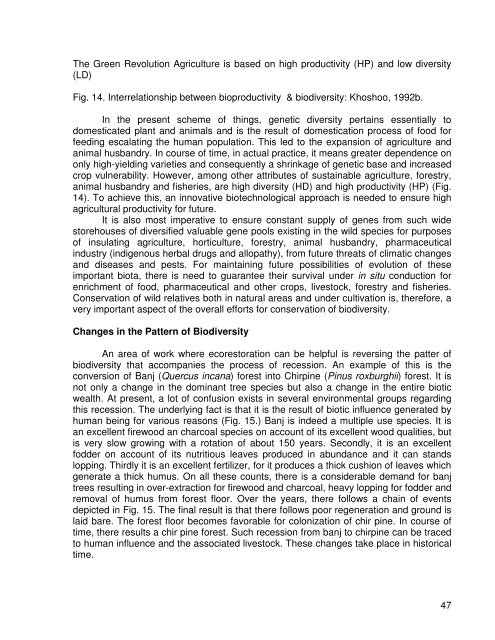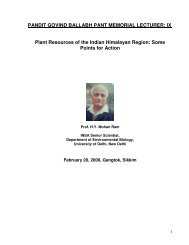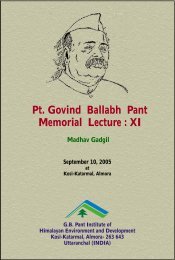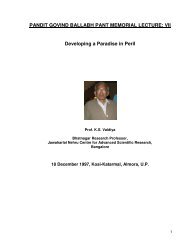Pandit Govind Ballabh Pant Memorial Lecture: II
Pandit Govind Ballabh Pant Memorial Lecture: II
Pandit Govind Ballabh Pant Memorial Lecture: II
You also want an ePaper? Increase the reach of your titles
YUMPU automatically turns print PDFs into web optimized ePapers that Google loves.
The Green Revolution Agriculture is based on high productivity (HP) and low diversity<br />
(LD)<br />
Fig. 14. Interrelationship between bioproductivity & biodiversity: Khoshoo, 1992b.<br />
In the present scheme of things, genetic diversity pertains essentially to<br />
domesticated plant and animals and is the result of domestication process of food for<br />
feeding escalating the human population. This led to the expansion of agriculture and<br />
animal husbandry. In course of time, in actual practice, it means greater dependence on<br />
only high-yielding varieties and consequently a shrinkage of genetic base and increased<br />
crop vulnerability. However, among other attributes of sustainable agriculture, forestry,<br />
animal husbandry and fisheries, are high diversity (HD) and high productivity (HP) (Fig.<br />
14). To achieve this, an innovative biotechnological approach is needed to ensure high<br />
agricultural productivity for future.<br />
It is also most imperative to ensure constant supply of genes from such wide<br />
storehouses of diversified valuable gene pools existing in the wild species for purposes<br />
of insulating agriculture, horticulture, forestry, animal husbandry, pharmaceutical<br />
industry (indigenous herbal drugs and allopathy), from future threats of climatic changes<br />
and diseases and pests. For maintaining future possibilities of evolution of these<br />
important biota, there is need to guarantee their survival under in situ conduction for<br />
enrichment of food, pharmaceutical and other crops, livestock, forestry and fisheries.<br />
Conservation of wild relatives both in natural areas and under cultivation is, therefore, a<br />
very important aspect of the overall efforts for conservation of biodiversity.<br />
Changes in the Pattern of Biodiversity<br />
An area of work where ecorestoration can be helpful is reversing the patter of<br />
biodiversity that accompanies the process of recession. An example of this is the<br />
conversion of Banj (Quercus incana) forest into Chirpine (Pinus roxburghii) forest. It is<br />
not only a change in the dominant tree species but also a change in the entire biotic<br />
wealth. At present, a lot of confusion exists in several environmental groups regarding<br />
this recession. The underlying fact is that it is the result of biotic influence generated by<br />
human being for various reasons (Fig. 15.) Banj is indeed a multiple use species. It is<br />
an excellent firewood an charcoal species on account of its excellent wood qualities, but<br />
is very slow growing with a rotation of about 150 years. Secondly, it is an excellent<br />
fodder on account of its nutritious leaves produced in abundance and it can stands<br />
lopping. Thirdly it is an excellent fertilizer, for it produces a thick cushion of leaves which<br />
generate a thick humus. On all these counts, there is a considerable demand for banj<br />
trees resulting in over-extraction for firewood and charcoal, heavy lopping for fodder and<br />
removal of humus from forest floor. Over the years, there follows a chain of events<br />
depicted in Fig. 15. The final result is that there follows poor regeneration and ground is<br />
laid bare. The forest floor becomes favorable for colonization of chir pine. In course of<br />
time, there results a chir pine forest. Such recession from banj to chirpine can be traced<br />
to human influence and the associated livestock. These changes take place in historical<br />
time.<br />
47











